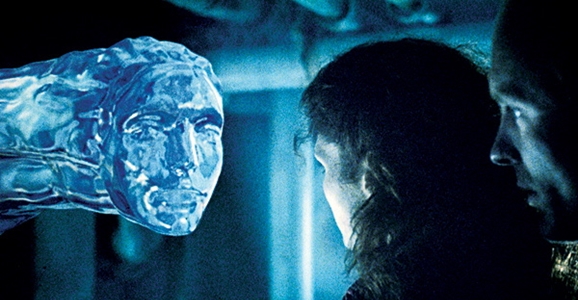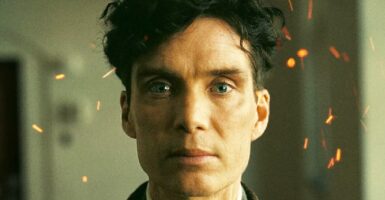VFX Artists’ Favorite Effects Shots Include The Abyss’ Water Tentacle, Blade Runner’s Cityscape, And More
This article is more than 2 years old
 Science fiction on the big screen has always hugged the curve of advancing technology, serving up ever-more-convincing creatures and starships and alien worlds (even when the effects are more convincing than the story or characters). So when Empire Magazine decided to ask some of the industry’s top visual effects artists about their favorite effects sequences in movie history, it’s no surprise that many of them cited moments from science fiction classics such as Blade Runner and The Abyss.
Science fiction on the big screen has always hugged the curve of advancing technology, serving up ever-more-convincing creatures and starships and alien worlds (even when the effects are more convincing than the story or characters). So when Empire Magazine decided to ask some of the industry’s top visual effects artists about their favorite effects sequences in movie history, it’s no surprise that many of them cited moments from science fiction classics such as Blade Runner and The Abyss.
Given how large a wake Stanley Kubrick’s 2001: A Space Odyssey has cast, it was pretty much a gimme for a list like this. Hell, there are even conspiracy theorists who use Kubrick’s convincing renderings of space travel as fodder to claim the director helped fake the Moon landings. Thankfully, ILM visual effects supervisor Roger Guyett doesn’t delve down that dark alley, instead singling out the film’s trippy climactic sequence.
I’m just amazed at the technical precision and finesse that they were able to bring to that work: it’s pretty flawless, even by today’s standards. They did all these amazing miniatures of the ships flying through space, but they also had all these esoteric aspects to the design, too. Doug Trumbull’s slit scan stuff is pretty awesome – the way he exposed through a narrow slot and created all these visual ideas of light and time travel – and Kubrick’s personality really shines through in the effects.
I’m tickled pink (or perhaps an apoxyic blue would be more appropriate) to see one of my very favorite movies of all time included on the list. James Cameron’s The Abyss never seems to get the praise as the director’s Aliens or Terminator movies, but it’s enraptured me from the first time I saw it as a kid. And that water tentacle? That water tentacle may not look like much now, but at the time: mind blown. Here’s what Method Studios VFX supervisor Erik-Jan De Boer has to say on the subject:
the fact that there was physical connection between Elizabeth Mastrantonio and the character were all breathtaking. She sticks her finger into that character and tastes it! You can’t really get a more physical connection than that. That whole production blew me away, from the fact that they filmed and lit it underwater to those stories of suffering on set. Even silly stuff that you rarely think about, like these black beads that they put on the water to keep the light out, because they couldn’t use a tarpaulin on the surface in case someone needed to surface. It was mind-blowing to realise what lengths people went to just to get a shot.
While Ridley Scott’s Blade Runner is rightly considered a genre classic — and still looks better on the big screen than most modern movies — but there isn’t really one “wowza” effects moment that stands out like some of the other things on this list. Instead, it impresses by creating a whole cohesive world that is absolutely convincing. But for Method Studios chief creative officer Dan Glass, it all comes down to that opening reveal of Los Angeles, 2019.
I’ve seen Blade Runner about eight or ten times and its opening scene is just fantastic – the way it spans the expanse of that city and integrates all this feeling and patience into aspects of this very credible future. As [a VFX artist] you aspire to that; to finding ways to bring pieces of reality, more organic elements sometimes, into things. Sadly, although they’re fantastic and there are directors like Chris Nolan who always want to use them, I think the future for miniatures is very limited and they suffer from their own limitations, too … Blade Runner was very, very early days but you still get this variety and naturalness that would take a lot of work to create digitally.
Chris Nolan’s Inception is one of the more recent picks on the list, and while there were plenty of amazing visuals to chose from, the unforgettable fight sequence set in a spinning, tumbling hotel corridor — or rather a dreamscape version of one. Fuel VFX supervisor Paul Butterworth lavishes the praise like so:
It’s one of those perfect marriages of director, supervisor and cinematographer, and them all getting it right together. As a supervisor you’re often panel-beating sequences into shape, so that harmony is your perfect wish. I think people want to know what happens behind the curtain but when they find out, there’s always a little disappointment, so I’m a fan of keeping the magic and not spoiling it for people. It’s kind of a shame that you get ‘makings-of’ on DVDs. In fact, I wish they’d make a bullshit ‘making-of’ to put some of the weird magic back. ‘Really, they used real dinosaurs?’
Last but certainly not least, we have yet another effect from yet another James Cameron movie…and one very similar to The Abyss’ water tentacle. The T-100 was an obvious evolution of the earlier tech that brought the water tentacle to life, and it ramped it up significantly by making it a key effect intrinsic to bringing to life one of the movie’s main characters. The T-1000 definitely made an impression on Reel FX digital director Augusto Schillaci:
“I’ve been doing this for 20 years now but the movie that made the biggest impression when I started out is Terminator 2. The integration of the T-1000 into that environment is something people take for granted now, but it wasn’t so simple at the time.
You can read the rest of Empire’s write-up over on their website.












